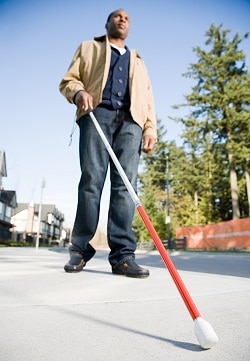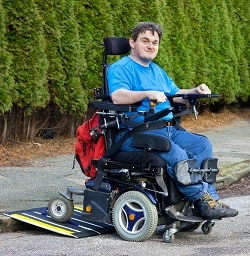Prevalence of Disabilities and Health Care Access by Disability Status and Type Among Adults — United States, 2016
People with Disabilities and Access to Health Care

The Morbidity and Mortality Weekly Report (MMWR) published a report describing adults with disabilities in the United States, as well as the differences in health care access by disability type. Using 2016 Behavioral Risk Factor Surveillance System (BRFSS) data, CDC scientists analyzed the survey responses of those adults 18 years of age and older who had any of the following six types of disabilities:
- Hearing (serious difficulty hearing);
- Vision (serious difficulty seeing);
- Cognition (serious difficulty concentrating, remembering, or making decisions);
- Mobility (serious difficulty walking or climbing stairs);
- Self-care (difficulty dressing or bathing); or
- Independent living (difficulty doing errands alone).
They found that 1 in 4 adults in the United States, or 61 million people, have at least one of these disabilities. Anyone can have a disability, and a disability can occur at any point in a person’s life. However, this report found disabilities more common among adults 65 years of age and older; approximately 2 in 5 adults in this age group have a disability. Disability was more commonly reported by women, non-Hispanic American Indians/Alaska Natives (AI/AN), adults with income below the federal poverty level, and adults living in the southern region of the United States. Researchers also found that, in general, adults 65 years of age and older with any disability reported better access to health care compared to younger adults with a disability. However, disability-specific disparities in health care access were common, particularly among young and middle-aged adults. Generally, adults with vision disability reported the least access to health care (i.e. health insurance coverage, usual health care provider, unmet health care need because of cost, and routine check-up within past 12 months) and adults with self-care disability reported the most access to care.
Research on the number of people with disabilities, their characteristics, and their disability-specific differences in health care access might enable health care professionals to address disability-specific barriers to health care, ensure inclusivity of health programs, and improve the health of people with disabilities.
Read the scientific summary (abstract) of this research.
Main Findings
Disability Findings
- Mobility disability was the most common disability, reported by approximately 1 in 7 adults, followed by cognition (1 in 10), independent living (1 in 15), hearing (1 in 17), vision (1 in 21), and self-care (1 in 27).
- Among young adults, cognitive disability (1 in 10) was the most common. Mobility disability was the most common among middle-aged (almost 1 in 5) and older adults (about 1 in 4).
- Percentages of adults with disability increased as poverty increased. In fact, mobility disability was nearly 5 times as common among middle-aged adults living below the poverty level compared to those whose income was twice the poverty level.
- All disability types were most often reported by women, with the exceptions of serious difficulty hearing (most often reported by men) and self-care (equally reported by men and women).
- Among adults aged 65 years and older, half of all AI/ANs (54.9%), Hispanics (50.5%), and those who reported that they are “other non-Hispanic race or multi-racial” (49.9%) reported a disability.
Health Care Access Findings
Researchers looked at the responses, given by people with disabilities, to four health care access questions:
- Health insurance coverage;
- Usual health care provider;
- Receipt of a routine check-up; and
- Cost barrier to health care need.
They found that, for each disability type, having health insurance coverage, a usual health care provider, and receiving a routine check-up increased with age, while having an unmet health care need because of cost decreased with age. Findings for specific age groups are outlined in the table below:
| Age Group | Health Care Access |
|---|---|
Older adults (65 years and older) |
|
Middle-aged adults (45-64 years) |
|
Young adults (18-44 years) |
|
About This Report
BRFSS is an ongoing state-based telephone survey of noninstitutionalized U.S. adults aged 18 years or older living in the community (not in group homes, for example). This is the first time a question about hearing difficulty has been included in the BRFSS, which may be why the number of people with disabilities is higher than previously reported (1 in 4 U.S. adults in 2016 versus 1 in 5 U.S. adults in 2013).
Implications
- This is the first time that questions about all six functional disability types have been included in a state-based health survey. This new information can help researchers and public health professionals better understand the characteristics of adults with disabilities, and therefore, better plan programs to address the needs of the different disability populations.
- The percentage of people who reported a disability varied among U.S. regions, reinforcing the importance of assuring that all people with disabilities receive the health care and support they need to improve the health and well-being of the entire population.
- Since the percentage of adults with disability is higher among certain groups, such as women, adults 65 years of age and older, adults with income below the federal poverty level, and non-Hispanic American Indians/Alaska Natives and those of other racial/ethnic groups, it is important that the programs and resources available for people with disabilities address the needs of these populations.
- Disability-specific challenges in accessing health care are common, particularly among young and middle-aged adults. Health care providers and public health practitioners need to be aware of these barriers and provide strategies to improve health care access and promote the inclusion of people with disabilities in disease prevention and health promotion programs.
Our Work
CDC supports 19 state disability and health programs and two National Centers on Health Promotion for People with Disabilities, all of which promote healthy lifestyles and work to improve quality of life for people with disabilities. The primary goals of the state programs are to
- Improve knowledge and awareness about the usefulness and effectiveness of programs, policies, systems, and environmental changes for people with select functional disability types (e.g., mobility and/or intellectual disabilities) and
- Support programs to plan, implement, evaluate, and disseminate non-research activities aimed at promoting inclusion and accessibility and reducing health disparities between people with or without disabilities.
The CDC’s Disability and Health website also provides information and resources that public health practitioners, health care providers, and others can use to increase awareness about disability inclusion, helping to ensure that every individual, with or without disabilities, can live, work, learn, and play in their communities.We encourage you to visit the Disability and Health website to find helpful information about disability inclusion and learn more about
- Barriers that keep people with disabilities from participating in their communities;
- Strategies to create inclusive communities; and
- Resources for inclusion of individuals with disabilities in public health programs and activities.
CDC also maintains the newly updated Disability and Health Data System (DHDS), an online interactive tool that provides instant access to state-level, disability-specific health data. Users can customize the disability and health data they view, making it easy to find health data on adults with and without disabilities and by functional disability type.
More Information
References
Okoro CA, Hollis ND, Cyrus AC, Griffin-Blake S. Prevalence of Disabilities and Health Care Access by Disability Status and Type Among Adults — United States, 2016. MMWR Morb Mortal Wkly Rep 2018;67:882–887. DOI: http://dx.doi.org/10.15585/mmwr.mm6732a3.
